Analysis of Tesco's Business Operations, Environment, and Functions
VerifiedAdded on 2021/01/02
|9
|1955
|257
Report
AI Summary
This report provides a comprehensive analysis of Tesco's business operations. It begins with an introduction to business environments and types of organizations, focusing specifically on Tesco. The report then delves into the importance of accounting, different functions carried out by the HR department, and key features of employee legislation. It includes an examination of Tesco's balance sheet, analyzing its financial position and investment strategies. The report also explores the role of teams, including Tuckman's theory of team development, and discusses future training events based on motivational theories and leadership styles. Finally, it covers the impact of customer service on business success. The report concludes by summarizing the key findings and referencing relevant academic sources.
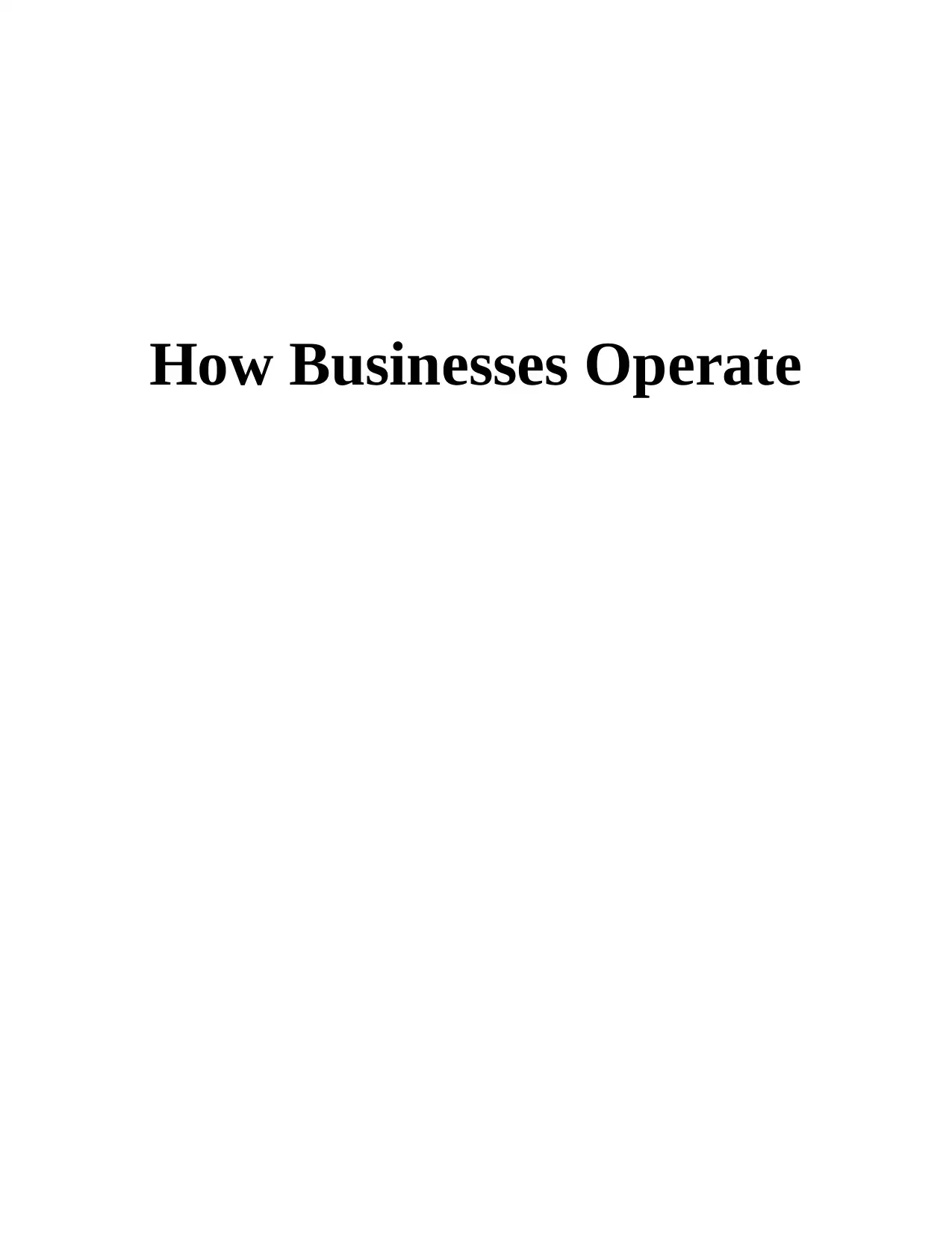
How Businesses Operate
Paraphrase This Document
Need a fresh take? Get an instant paraphrase of this document with our AI Paraphraser
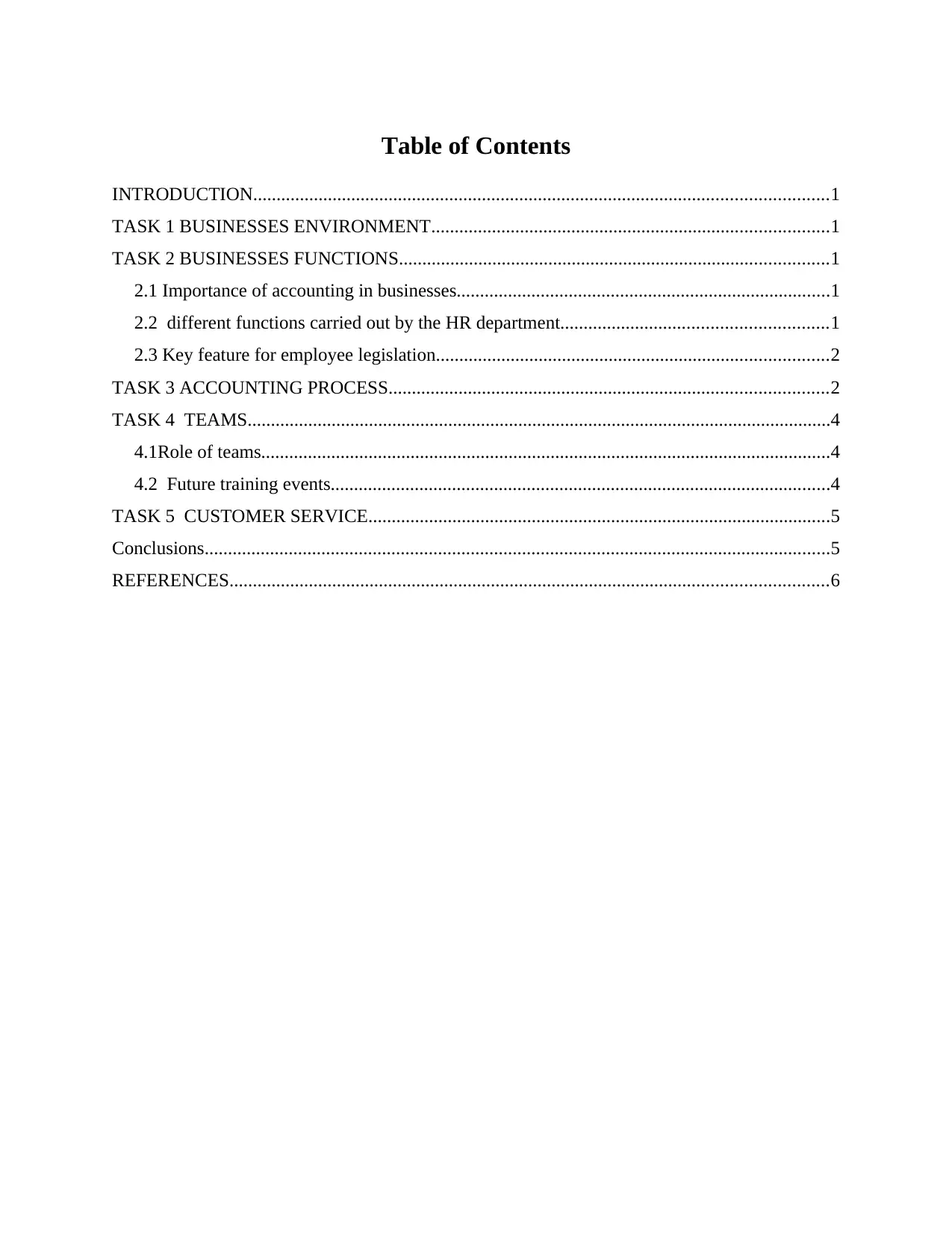
Table of Contents
INTRODUCTION...........................................................................................................................1
TASK 1 BUSINESSES ENVIRONMENT.....................................................................................1
TASK 2 BUSINESSES FUNCTIONS............................................................................................1
2.1 Importance of accounting in businesses................................................................................1
2.2 different functions carried out by the HR department.........................................................1
2.3 Key feature for employee legislation....................................................................................2
TASK 3 ACCOUNTING PROCESS..............................................................................................2
TASK 4 TEAMS.............................................................................................................................4
4.1Role of teams..........................................................................................................................4
4.2 Future training events...........................................................................................................4
TASK 5 CUSTOMER SERVICE...................................................................................................5
Conclusions......................................................................................................................................5
REFERENCES................................................................................................................................6
INTRODUCTION...........................................................................................................................1
TASK 1 BUSINESSES ENVIRONMENT.....................................................................................1
TASK 2 BUSINESSES FUNCTIONS............................................................................................1
2.1 Importance of accounting in businesses................................................................................1
2.2 different functions carried out by the HR department.........................................................1
2.3 Key feature for employee legislation....................................................................................2
TASK 3 ACCOUNTING PROCESS..............................................................................................2
TASK 4 TEAMS.............................................................................................................................4
4.1Role of teams..........................................................................................................................4
4.2 Future training events...........................................................................................................4
TASK 5 CUSTOMER SERVICE...................................................................................................5
Conclusions......................................................................................................................................5
REFERENCES................................................................................................................................6
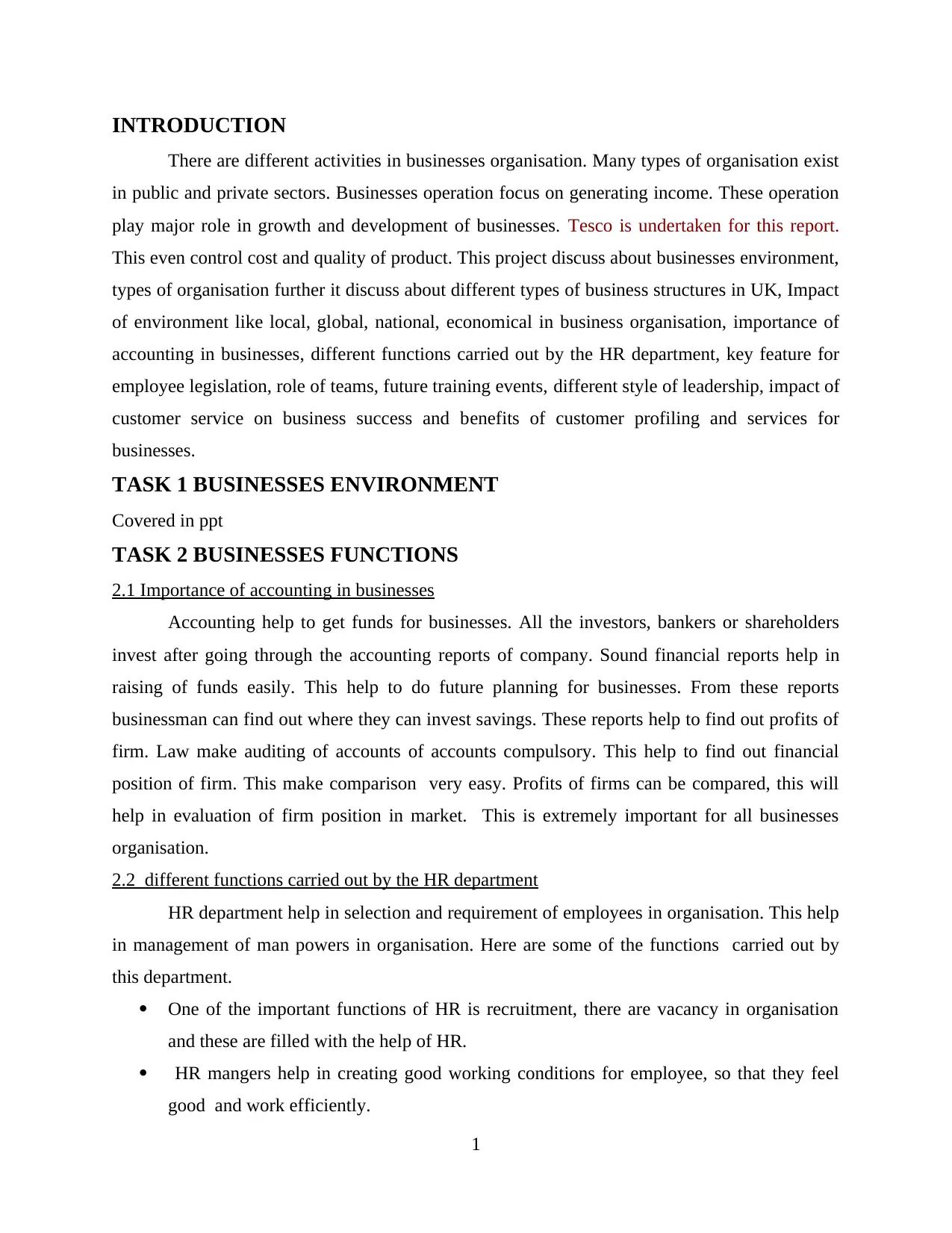
INTRODUCTION
There are different activities in businesses organisation. Many types of organisation exist
in public and private sectors. Businesses operation focus on generating income. These operation
play major role in growth and development of businesses. Tesco is undertaken for this report.
This even control cost and quality of product. This project discuss about businesses environment,
types of organisation further it discuss about different types of business structures in UK, Impact
of environment like local, global, national, economical in business organisation, importance of
accounting in businesses, different functions carried out by the HR department, key feature for
employee legislation, role of teams, future training events, different style of leadership, impact of
customer service on business success and benefits of customer profiling and services for
businesses.
TASK 1 BUSINESSES ENVIRONMENT
Covered in ppt
TASK 2 BUSINESSES FUNCTIONS
2.1 Importance of accounting in businesses
Accounting help to get funds for businesses. All the investors, bankers or shareholders
invest after going through the accounting reports of company. Sound financial reports help in
raising of funds easily. This help to do future planning for businesses. From these reports
businessman can find out where they can invest savings. These reports help to find out profits of
firm. Law make auditing of accounts of accounts compulsory. This help to find out financial
position of firm. This make comparison very easy. Profits of firms can be compared, this will
help in evaluation of firm position in market. This is extremely important for all businesses
organisation.
2.2 different functions carried out by the HR department
HR department help in selection and requirement of employees in organisation. This help
in management of man powers in organisation. Here are some of the functions carried out by
this department.
One of the important functions of HR is recruitment, there are vacancy in organisation
and these are filled with the help of HR.
HR mangers help in creating good working conditions for employee, so that they feel
good and work efficiently.
1
There are different activities in businesses organisation. Many types of organisation exist
in public and private sectors. Businesses operation focus on generating income. These operation
play major role in growth and development of businesses. Tesco is undertaken for this report.
This even control cost and quality of product. This project discuss about businesses environment,
types of organisation further it discuss about different types of business structures in UK, Impact
of environment like local, global, national, economical in business organisation, importance of
accounting in businesses, different functions carried out by the HR department, key feature for
employee legislation, role of teams, future training events, different style of leadership, impact of
customer service on business success and benefits of customer profiling and services for
businesses.
TASK 1 BUSINESSES ENVIRONMENT
Covered in ppt
TASK 2 BUSINESSES FUNCTIONS
2.1 Importance of accounting in businesses
Accounting help to get funds for businesses. All the investors, bankers or shareholders
invest after going through the accounting reports of company. Sound financial reports help in
raising of funds easily. This help to do future planning for businesses. From these reports
businessman can find out where they can invest savings. These reports help to find out profits of
firm. Law make auditing of accounts of accounts compulsory. This help to find out financial
position of firm. This make comparison very easy. Profits of firms can be compared, this will
help in evaluation of firm position in market. This is extremely important for all businesses
organisation.
2.2 different functions carried out by the HR department
HR department help in selection and requirement of employees in organisation. This help
in management of man powers in organisation. Here are some of the functions carried out by
this department.
One of the important functions of HR is recruitment, there are vacancy in organisation
and these are filled with the help of HR.
HR mangers help in creating good working conditions for employee, so that they feel
good and work efficiently.
1
⊘ This is a preview!⊘
Do you want full access?
Subscribe today to unlock all pages.

Trusted by 1+ million students worldwide
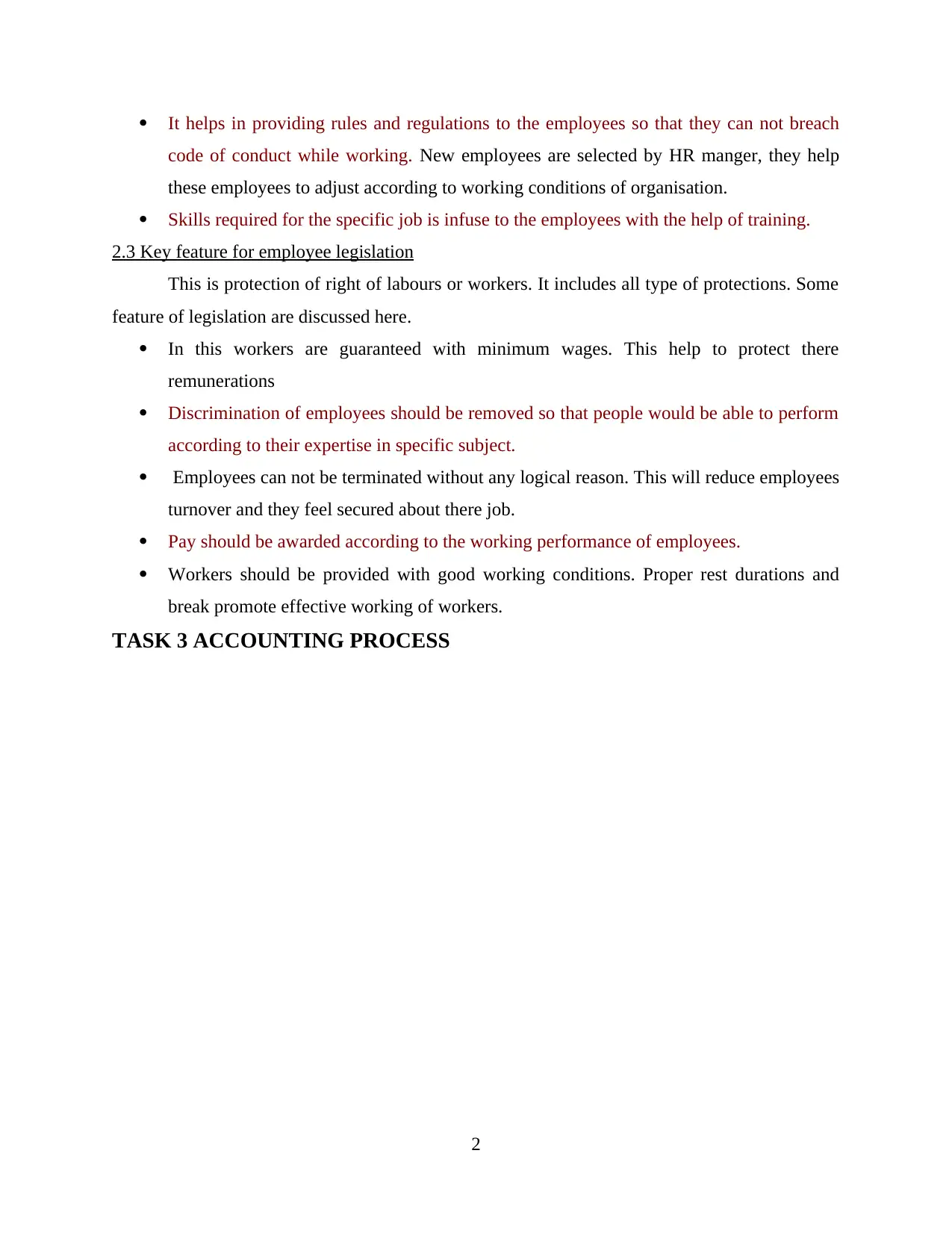
It helps in providing rules and regulations to the employees so that they can not breach
code of conduct while working. New employees are selected by HR manger, they help
these employees to adjust according to working conditions of organisation.
Skills required for the specific job is infuse to the employees with the help of training.
2.3 Key feature for employee legislation
This is protection of right of labours or workers. It includes all type of protections. Some
feature of legislation are discussed here.
In this workers are guaranteed with minimum wages. This help to protect there
remunerations
Discrimination of employees should be removed so that people would be able to perform
according to their expertise in specific subject.
Employees can not be terminated without any logical reason. This will reduce employees
turnover and they feel secured about there job.
Pay should be awarded according to the working performance of employees.
Workers should be provided with good working conditions. Proper rest durations and
break promote effective working of workers.
TASK 3 ACCOUNTING PROCESS
2
code of conduct while working. New employees are selected by HR manger, they help
these employees to adjust according to working conditions of organisation.
Skills required for the specific job is infuse to the employees with the help of training.
2.3 Key feature for employee legislation
This is protection of right of labours or workers. It includes all type of protections. Some
feature of legislation are discussed here.
In this workers are guaranteed with minimum wages. This help to protect there
remunerations
Discrimination of employees should be removed so that people would be able to perform
according to their expertise in specific subject.
Employees can not be terminated without any logical reason. This will reduce employees
turnover and they feel secured about there job.
Pay should be awarded according to the working performance of employees.
Workers should be provided with good working conditions. Proper rest durations and
break promote effective working of workers.
TASK 3 ACCOUNTING PROCESS
2
Paraphrase This Document
Need a fresh take? Get an instant paraphrase of this document with our AI Paraphraser
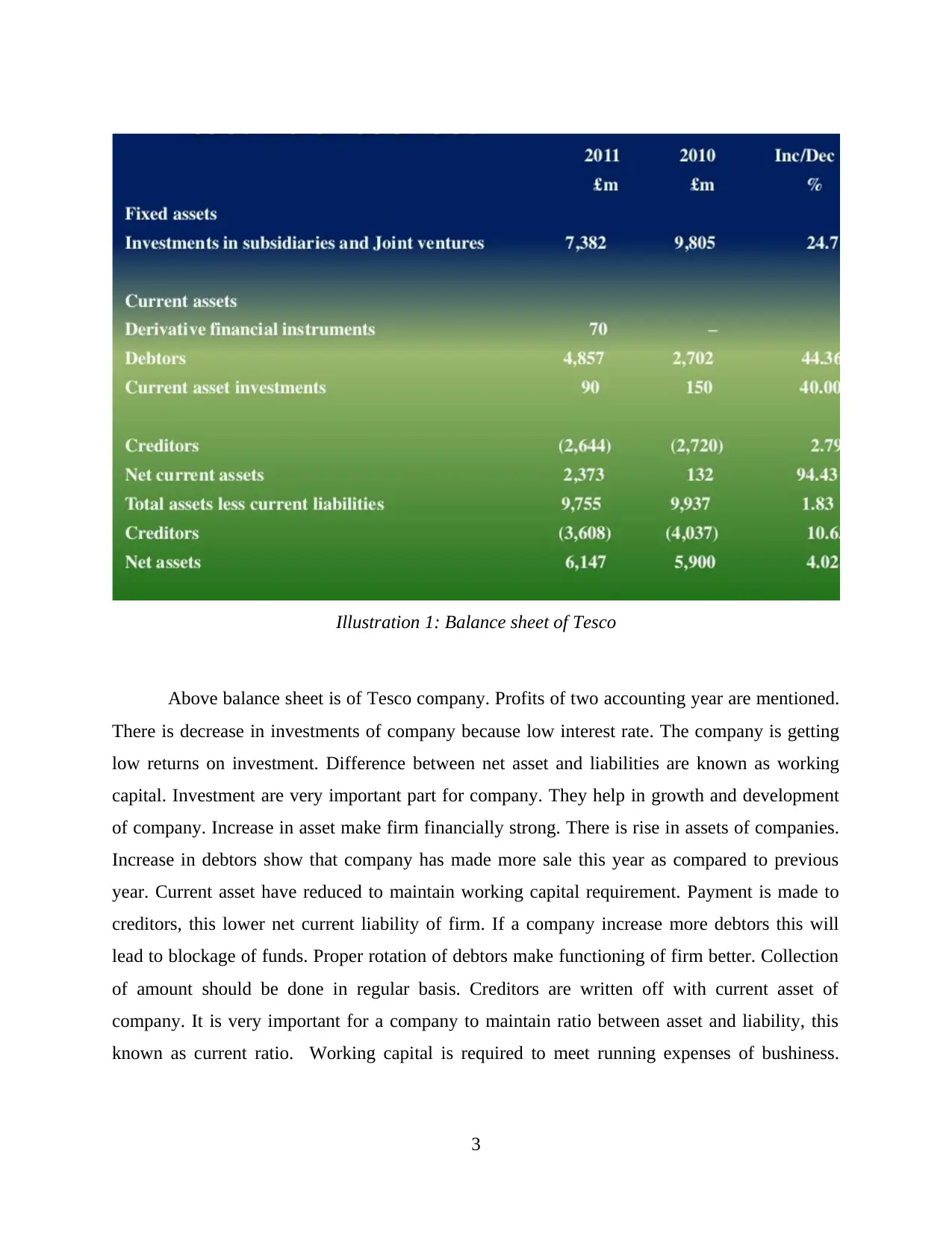
Above balance sheet is of Tesco company. Profits of two accounting year are mentioned.
There is decrease in investments of company because low interest rate. The company is getting
low returns on investment. Difference between net asset and liabilities are known as working
capital. Investment are very important part for company. They help in growth and development
of company. Increase in asset make firm financially strong. There is rise in assets of companies.
Increase in debtors show that company has made more sale this year as compared to previous
year. Current asset have reduced to maintain working capital requirement. Payment is made to
creditors, this lower net current liability of firm. If a company increase more debtors this will
lead to blockage of funds. Proper rotation of debtors make functioning of firm better. Collection
of amount should be done in regular basis. Creditors are written off with current asset of
company. It is very important for a company to maintain ratio between asset and liability, this
known as current ratio. Working capital is required to meet running expenses of bushiness.
3
Illustration 1: Balance sheet of Tesco
There is decrease in investments of company because low interest rate. The company is getting
low returns on investment. Difference between net asset and liabilities are known as working
capital. Investment are very important part for company. They help in growth and development
of company. Increase in asset make firm financially strong. There is rise in assets of companies.
Increase in debtors show that company has made more sale this year as compared to previous
year. Current asset have reduced to maintain working capital requirement. Payment is made to
creditors, this lower net current liability of firm. If a company increase more debtors this will
lead to blockage of funds. Proper rotation of debtors make functioning of firm better. Collection
of amount should be done in regular basis. Creditors are written off with current asset of
company. It is very important for a company to maintain ratio between asset and liability, this
known as current ratio. Working capital is required to meet running expenses of bushiness.
3
Illustration 1: Balance sheet of Tesco
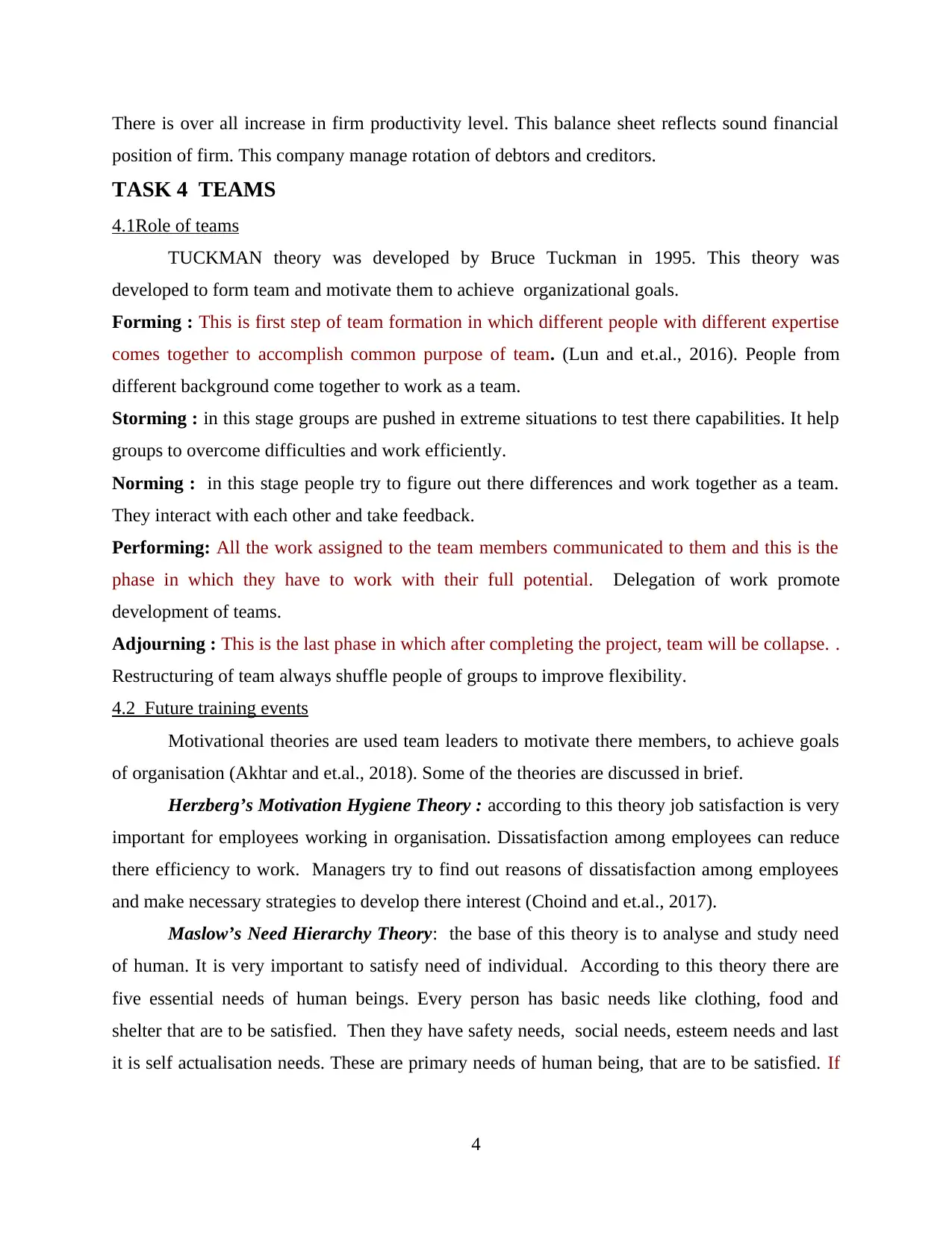
There is over all increase in firm productivity level. This balance sheet reflects sound financial
position of firm. This company manage rotation of debtors and creditors.
TASK 4 TEAMS
4.1Role of teams
TUCKMAN theory was developed by Bruce Tuckman in 1995. This theory was
developed to form team and motivate them to achieve organizational goals.
Forming : This is first step of team formation in which different people with different expertise
comes together to accomplish common purpose of team. (Lun and et.al., 2016). People from
different background come together to work as a team.
Storming : in this stage groups are pushed in extreme situations to test there capabilities. It help
groups to overcome difficulties and work efficiently.
Norming : in this stage people try to figure out there differences and work together as a team.
They interact with each other and take feedback.
Performing: All the work assigned to the team members communicated to them and this is the
phase in which they have to work with their full potential. Delegation of work promote
development of teams.
Adjourning : This is the last phase in which after completing the project, team will be collapse. .
Restructuring of team always shuffle people of groups to improve flexibility.
4.2 Future training events
Motivational theories are used team leaders to motivate there members, to achieve goals
of organisation (Akhtar and et.al., 2018). Some of the theories are discussed in brief.
Herzberg’s Motivation Hygiene Theory : according to this theory job satisfaction is very
important for employees working in organisation. Dissatisfaction among employees can reduce
there efficiency to work. Managers try to find out reasons of dissatisfaction among employees
and make necessary strategies to develop there interest (Choind and et.al., 2017).
Maslow’s Need Hierarchy Theory: the base of this theory is to analyse and study need
of human. It is very important to satisfy need of individual. According to this theory there are
five essential needs of human beings. Every person has basic needs like clothing, food and
shelter that are to be satisfied. Then they have safety needs, social needs, esteem needs and last
it is self actualisation needs. These are primary needs of human being, that are to be satisfied. If
4
position of firm. This company manage rotation of debtors and creditors.
TASK 4 TEAMS
4.1Role of teams
TUCKMAN theory was developed by Bruce Tuckman in 1995. This theory was
developed to form team and motivate them to achieve organizational goals.
Forming : This is first step of team formation in which different people with different expertise
comes together to accomplish common purpose of team. (Lun and et.al., 2016). People from
different background come together to work as a team.
Storming : in this stage groups are pushed in extreme situations to test there capabilities. It help
groups to overcome difficulties and work efficiently.
Norming : in this stage people try to figure out there differences and work together as a team.
They interact with each other and take feedback.
Performing: All the work assigned to the team members communicated to them and this is the
phase in which they have to work with their full potential. Delegation of work promote
development of teams.
Adjourning : This is the last phase in which after completing the project, team will be collapse. .
Restructuring of team always shuffle people of groups to improve flexibility.
4.2 Future training events
Motivational theories are used team leaders to motivate there members, to achieve goals
of organisation (Akhtar and et.al., 2018). Some of the theories are discussed in brief.
Herzberg’s Motivation Hygiene Theory : according to this theory job satisfaction is very
important for employees working in organisation. Dissatisfaction among employees can reduce
there efficiency to work. Managers try to find out reasons of dissatisfaction among employees
and make necessary strategies to develop there interest (Choind and et.al., 2017).
Maslow’s Need Hierarchy Theory: the base of this theory is to analyse and study need
of human. It is very important to satisfy need of individual. According to this theory there are
five essential needs of human beings. Every person has basic needs like clothing, food and
shelter that are to be satisfied. Then they have safety needs, social needs, esteem needs and last
it is self actualisation needs. These are primary needs of human being, that are to be satisfied. If
4
⊘ This is a preview!⊘
Do you want full access?
Subscribe today to unlock all pages.

Trusted by 1+ million students worldwide
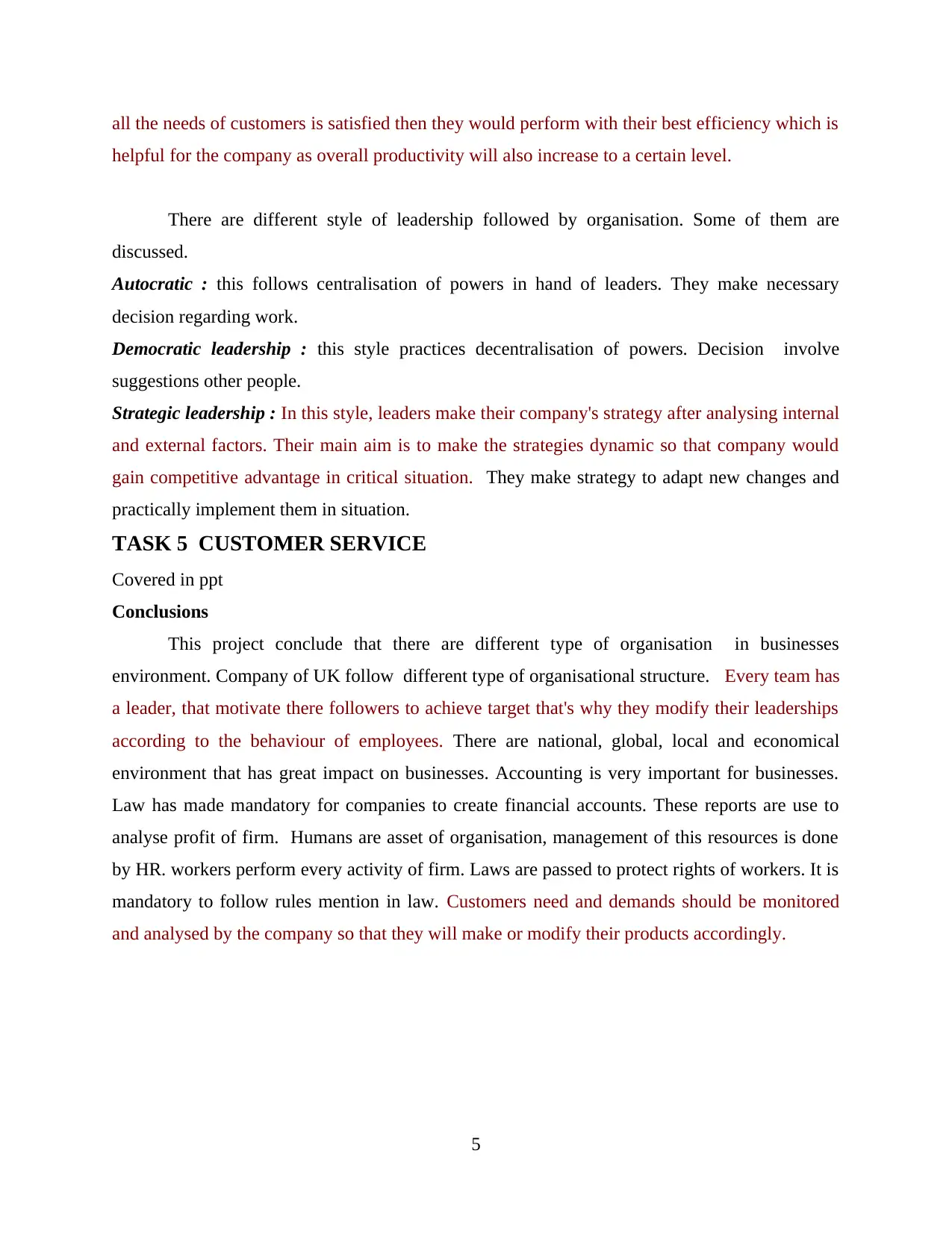
all the needs of customers is satisfied then they would perform with their best efficiency which is
helpful for the company as overall productivity will also increase to a certain level.
There are different style of leadership followed by organisation. Some of them are
discussed.
Autocratic : this follows centralisation of powers in hand of leaders. They make necessary
decision regarding work.
Democratic leadership : this style practices decentralisation of powers. Decision involve
suggestions other people.
Strategic leadership : In this style, leaders make their company's strategy after analysing internal
and external factors. Their main aim is to make the strategies dynamic so that company would
gain competitive advantage in critical situation. They make strategy to adapt new changes and
practically implement them in situation.
TASK 5 CUSTOMER SERVICE
Covered in ppt
Conclusions
This project conclude that there are different type of organisation in businesses
environment. Company of UK follow different type of organisational structure. Every team has
a leader, that motivate there followers to achieve target that's why they modify their leaderships
according to the behaviour of employees. There are national, global, local and economical
environment that has great impact on businesses. Accounting is very important for businesses.
Law has made mandatory for companies to create financial accounts. These reports are use to
analyse profit of firm. Humans are asset of organisation, management of this resources is done
by HR. workers perform every activity of firm. Laws are passed to protect rights of workers. It is
mandatory to follow rules mention in law. Customers need and demands should be monitored
and analysed by the company so that they will make or modify their products accordingly.
5
helpful for the company as overall productivity will also increase to a certain level.
There are different style of leadership followed by organisation. Some of them are
discussed.
Autocratic : this follows centralisation of powers in hand of leaders. They make necessary
decision regarding work.
Democratic leadership : this style practices decentralisation of powers. Decision involve
suggestions other people.
Strategic leadership : In this style, leaders make their company's strategy after analysing internal
and external factors. Their main aim is to make the strategies dynamic so that company would
gain competitive advantage in critical situation. They make strategy to adapt new changes and
practically implement them in situation.
TASK 5 CUSTOMER SERVICE
Covered in ppt
Conclusions
This project conclude that there are different type of organisation in businesses
environment. Company of UK follow different type of organisational structure. Every team has
a leader, that motivate there followers to achieve target that's why they modify their leaderships
according to the behaviour of employees. There are national, global, local and economical
environment that has great impact on businesses. Accounting is very important for businesses.
Law has made mandatory for companies to create financial accounts. These reports are use to
analyse profit of firm. Humans are asset of organisation, management of this resources is done
by HR. workers perform every activity of firm. Laws are passed to protect rights of workers. It is
mandatory to follow rules mention in law. Customers need and demands should be monitored
and analysed by the company so that they will make or modify their products accordingly.
5
Paraphrase This Document
Need a fresh take? Get an instant paraphrase of this document with our AI Paraphraser
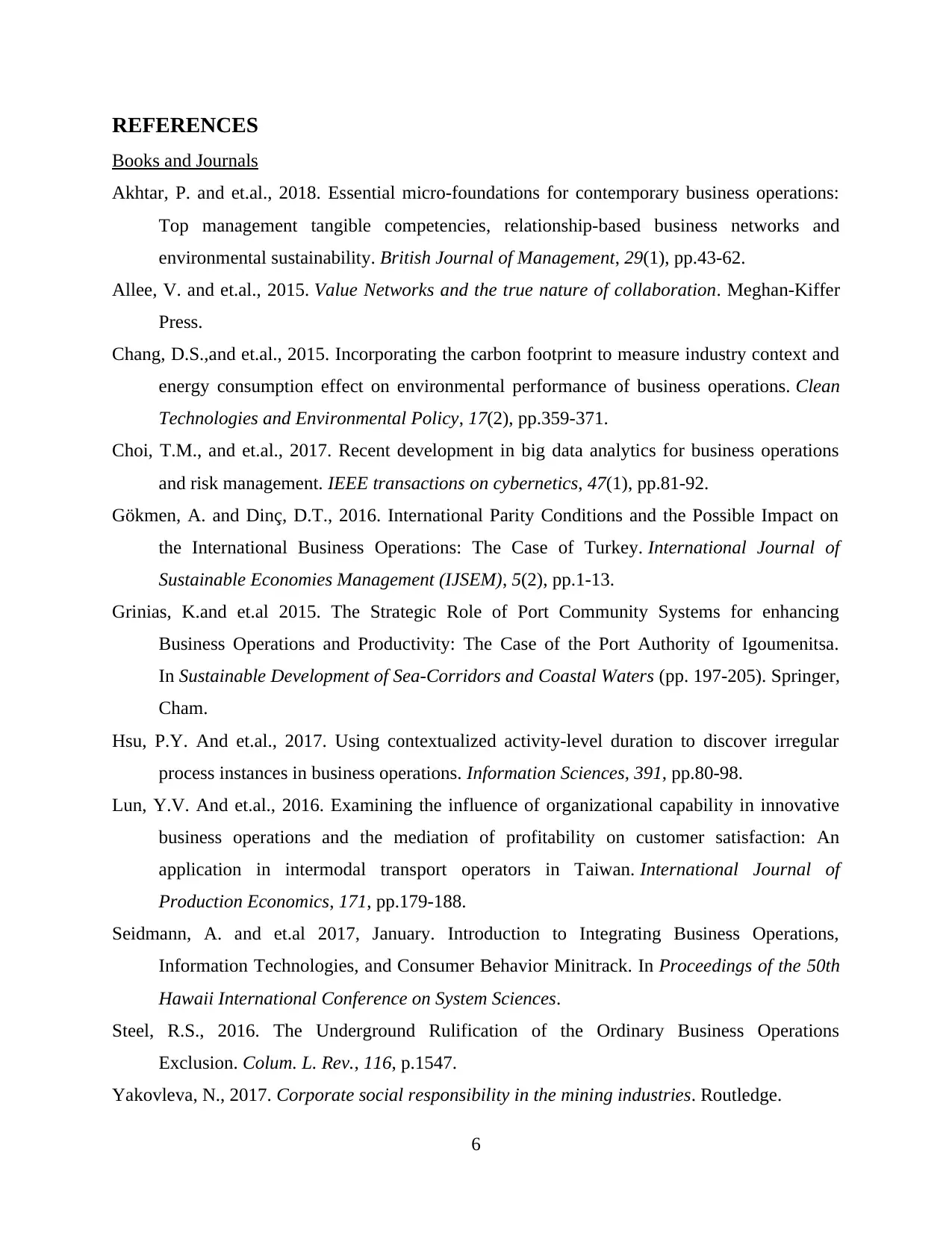
REFERENCES
Books and Journals
Akhtar, P. and et.al., 2018. Essential micro‐foundations for contemporary business operations:
Top management tangible competencies, relationship‐based business networks and
environmental sustainability. British Journal of Management, 29(1), pp.43-62.
Allee, V. and et.al., 2015. Value Networks and the true nature of collaboration. Meghan-Kiffer
Press.
Chang, D.S.,and et.al., 2015. Incorporating the carbon footprint to measure industry context and
energy consumption effect on environmental performance of business operations. Clean
Technologies and Environmental Policy, 17(2), pp.359-371.
Choi, T.M., and et.al., 2017. Recent development in big data analytics for business operations
and risk management. IEEE transactions on cybernetics, 47(1), pp.81-92.
Gökmen, A. and Dinç, D.T., 2016. International Parity Conditions and the Possible Impact on
the International Business Operations: The Case of Turkey. International Journal of
Sustainable Economies Management (IJSEM), 5(2), pp.1-13.
Grinias, K.and et.al 2015. The Strategic Role of Port Community Systems for enhancing
Business Operations and Productivity: The Case of the Port Authority of Igoumenitsa.
In Sustainable Development of Sea-Corridors and Coastal Waters (pp. 197-205). Springer,
Cham.
Hsu, P.Y. And et.al., 2017. Using contextualized activity-level duration to discover irregular
process instances in business operations. Information Sciences, 391, pp.80-98.
Lun, Y.V. And et.al., 2016. Examining the influence of organizational capability in innovative
business operations and the mediation of profitability on customer satisfaction: An
application in intermodal transport operators in Taiwan. International Journal of
Production Economics, 171, pp.179-188.
Seidmann, A. and et.al 2017, January. Introduction to Integrating Business Operations,
Information Technologies, and Consumer Behavior Minitrack. In Proceedings of the 50th
Hawaii International Conference on System Sciences.
Steel, R.S., 2016. The Underground Rulification of the Ordinary Business Operations
Exclusion. Colum. L. Rev., 116, p.1547.
Yakovleva, N., 2017. Corporate social responsibility in the mining industries. Routledge.
6
Books and Journals
Akhtar, P. and et.al., 2018. Essential micro‐foundations for contemporary business operations:
Top management tangible competencies, relationship‐based business networks and
environmental sustainability. British Journal of Management, 29(1), pp.43-62.
Allee, V. and et.al., 2015. Value Networks and the true nature of collaboration. Meghan-Kiffer
Press.
Chang, D.S.,and et.al., 2015. Incorporating the carbon footprint to measure industry context and
energy consumption effect on environmental performance of business operations. Clean
Technologies and Environmental Policy, 17(2), pp.359-371.
Choi, T.M., and et.al., 2017. Recent development in big data analytics for business operations
and risk management. IEEE transactions on cybernetics, 47(1), pp.81-92.
Gökmen, A. and Dinç, D.T., 2016. International Parity Conditions and the Possible Impact on
the International Business Operations: The Case of Turkey. International Journal of
Sustainable Economies Management (IJSEM), 5(2), pp.1-13.
Grinias, K.and et.al 2015. The Strategic Role of Port Community Systems for enhancing
Business Operations and Productivity: The Case of the Port Authority of Igoumenitsa.
In Sustainable Development of Sea-Corridors and Coastal Waters (pp. 197-205). Springer,
Cham.
Hsu, P.Y. And et.al., 2017. Using contextualized activity-level duration to discover irregular
process instances in business operations. Information Sciences, 391, pp.80-98.
Lun, Y.V. And et.al., 2016. Examining the influence of organizational capability in innovative
business operations and the mediation of profitability on customer satisfaction: An
application in intermodal transport operators in Taiwan. International Journal of
Production Economics, 171, pp.179-188.
Seidmann, A. and et.al 2017, January. Introduction to Integrating Business Operations,
Information Technologies, and Consumer Behavior Minitrack. In Proceedings of the 50th
Hawaii International Conference on System Sciences.
Steel, R.S., 2016. The Underground Rulification of the Ordinary Business Operations
Exclusion. Colum. L. Rev., 116, p.1547.
Yakovleva, N., 2017. Corporate social responsibility in the mining industries. Routledge.
6

7
⊘ This is a preview!⊘
Do you want full access?
Subscribe today to unlock all pages.

Trusted by 1+ million students worldwide
1 out of 9
Related Documents
Your All-in-One AI-Powered Toolkit for Academic Success.
+13062052269
info@desklib.com
Available 24*7 on WhatsApp / Email
![[object Object]](/_next/static/media/star-bottom.7253800d.svg)
Unlock your academic potential
Copyright © 2020–2025 A2Z Services. All Rights Reserved. Developed and managed by ZUCOL.





